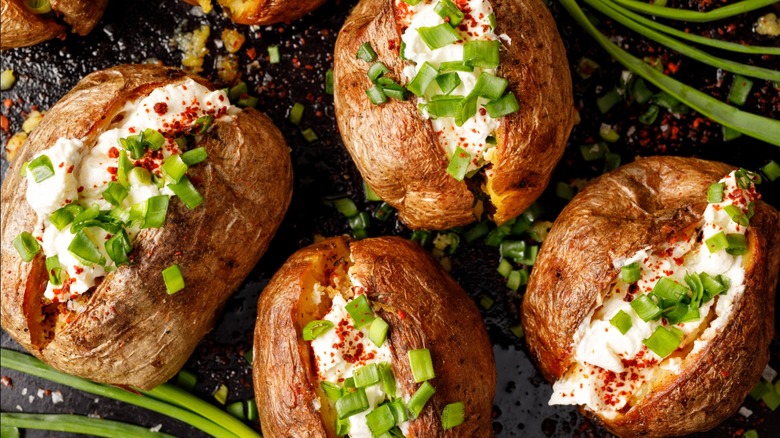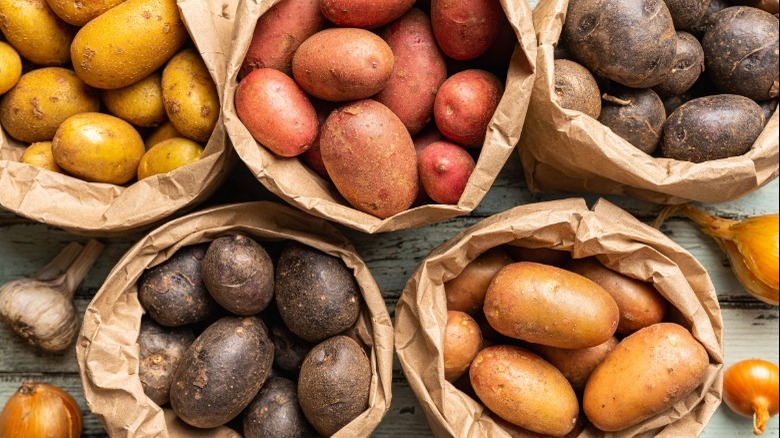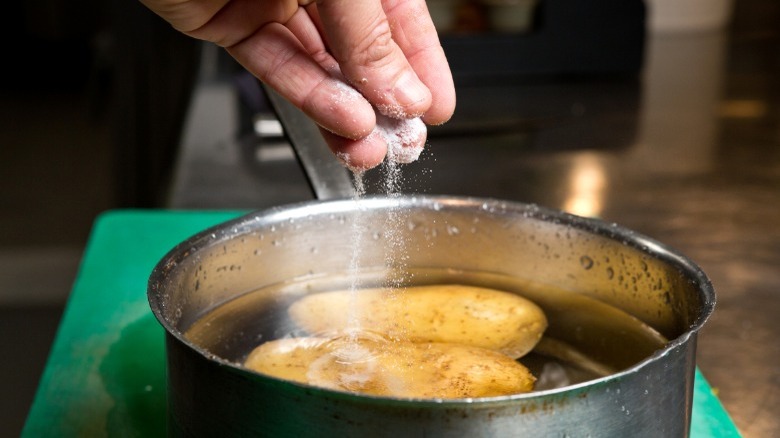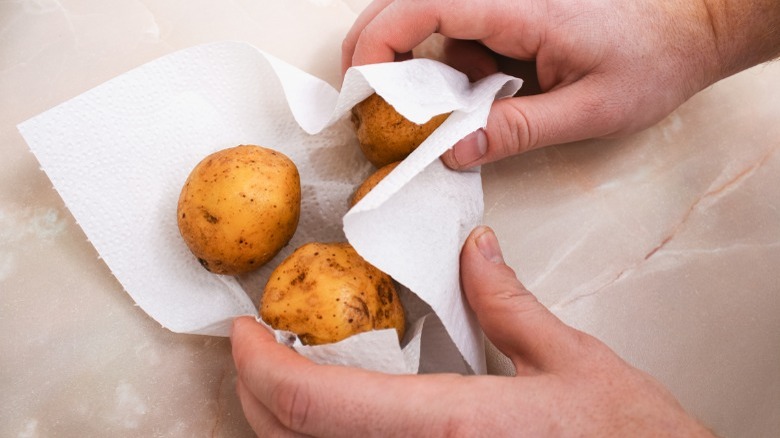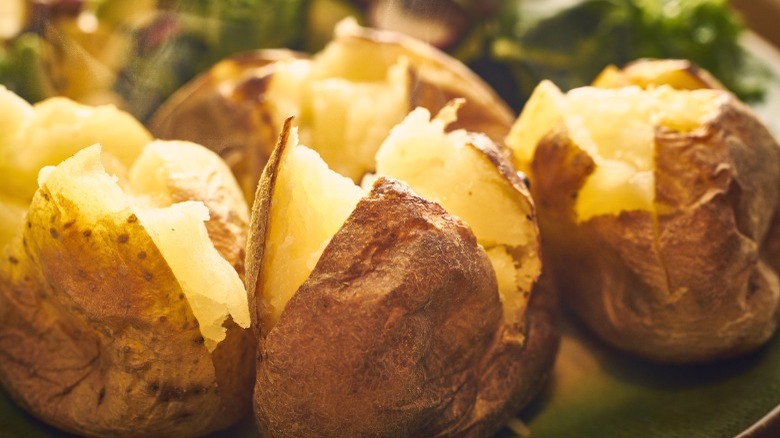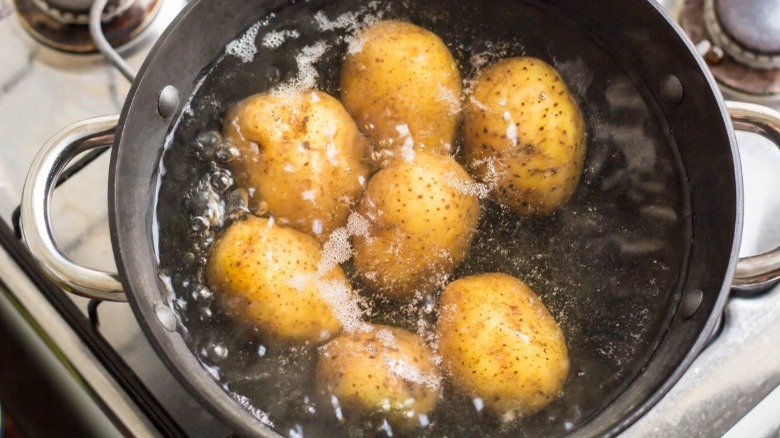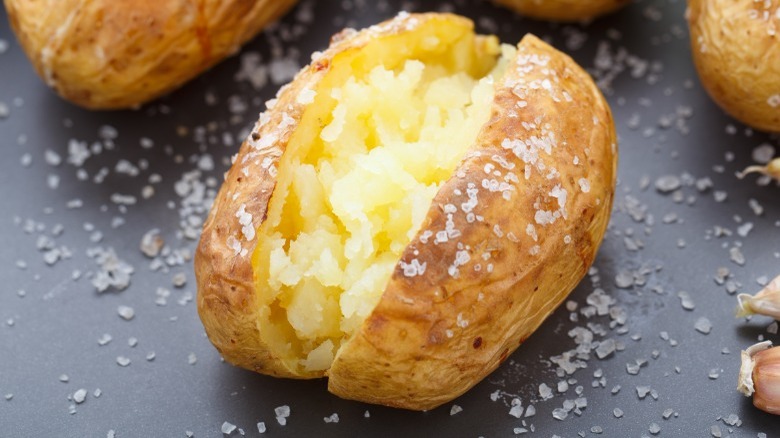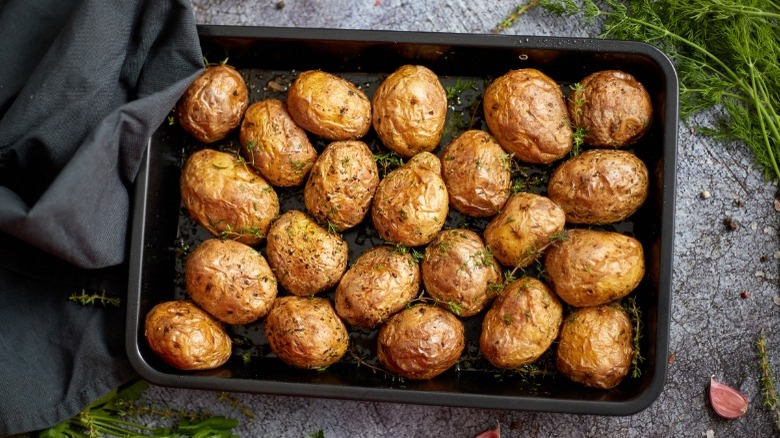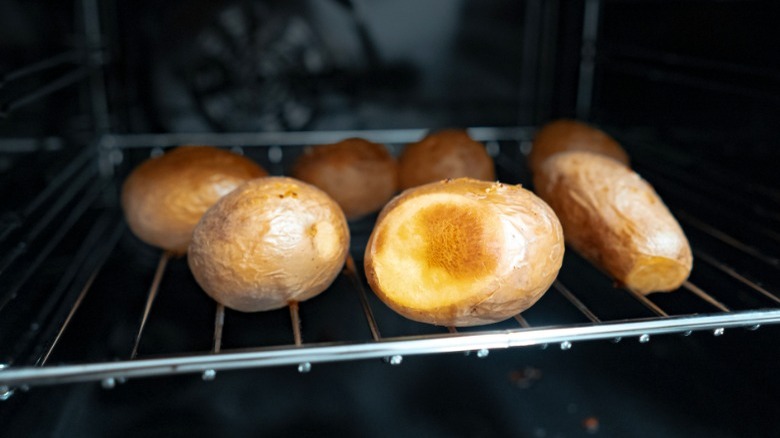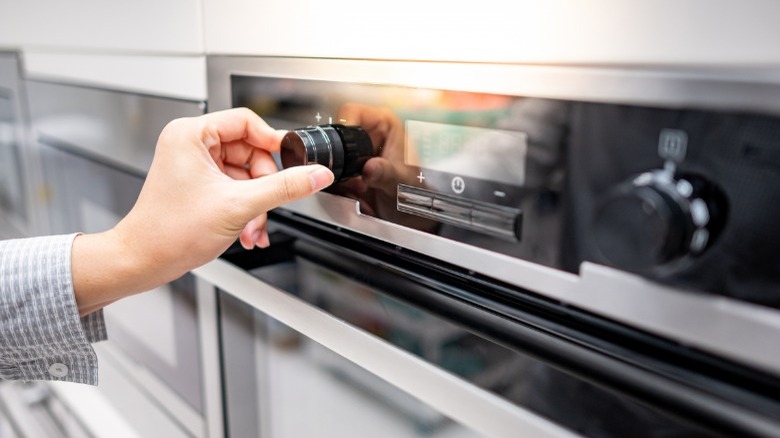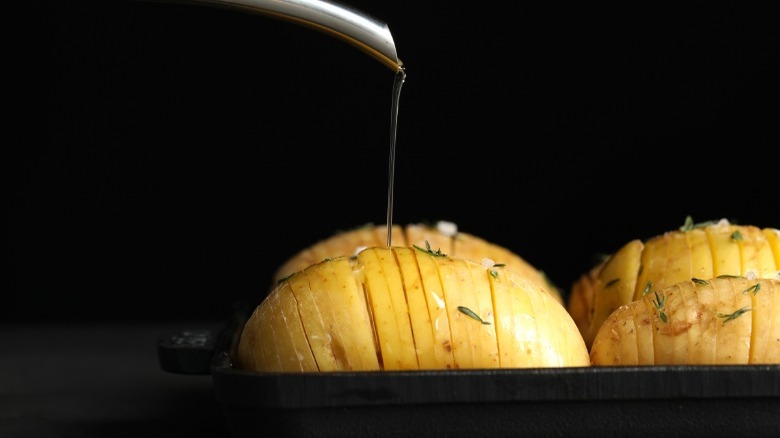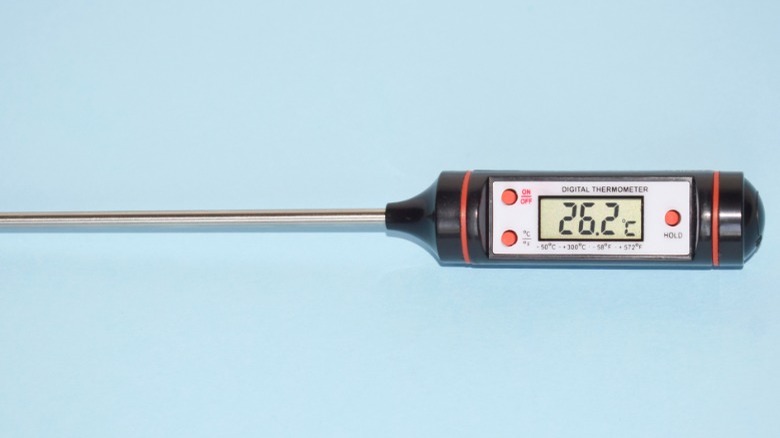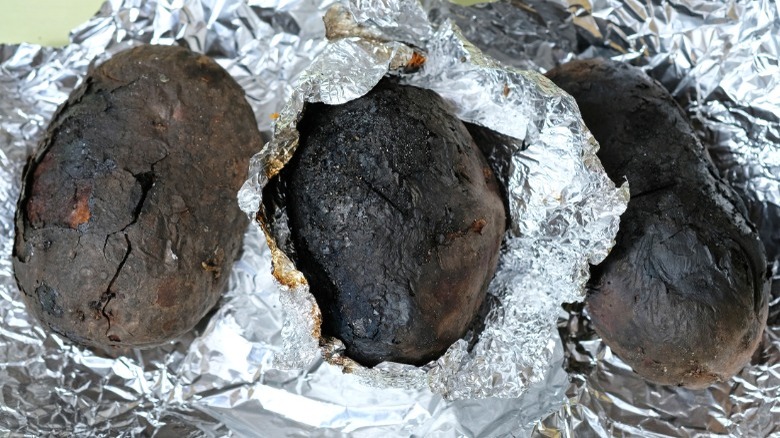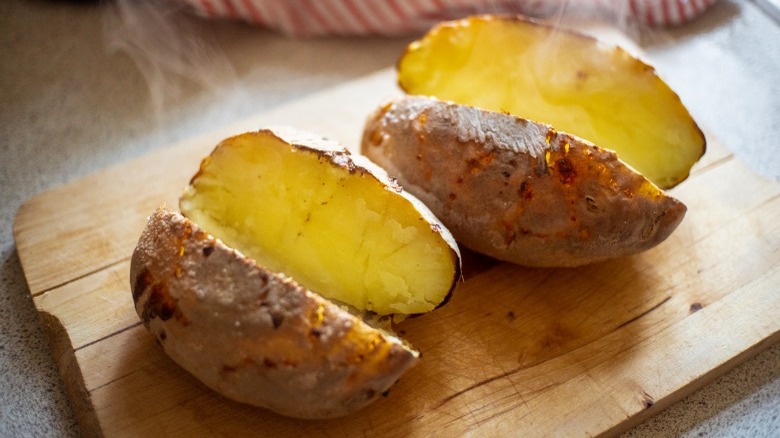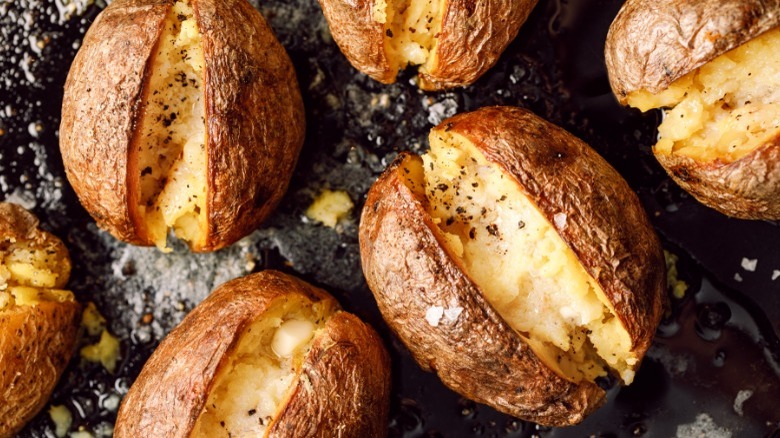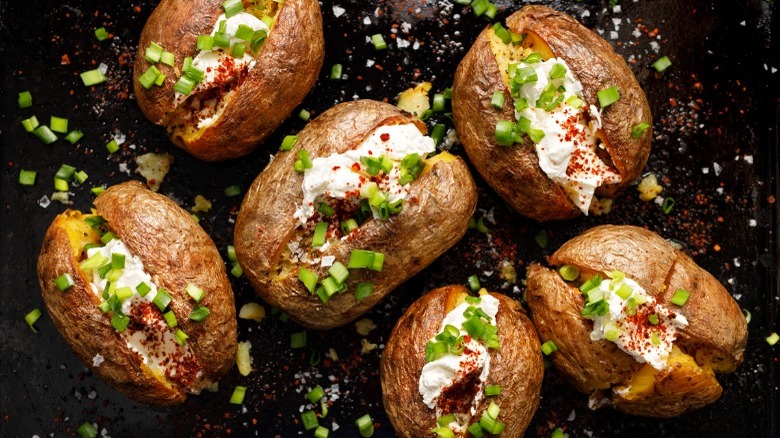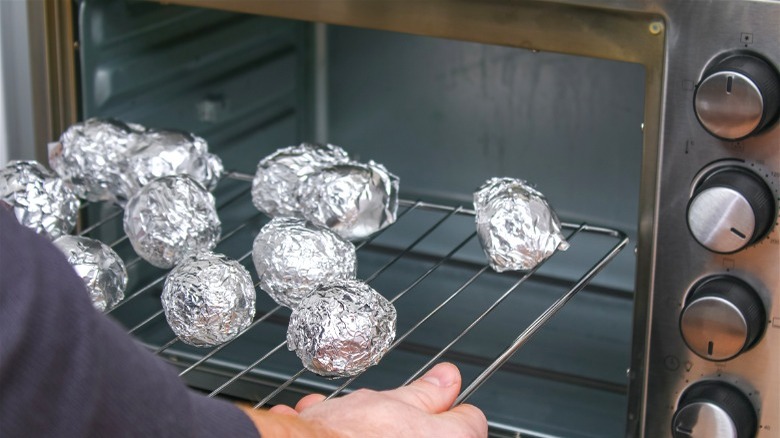16 Ways You're Ruining Your Baked Potatoes
If you're a fan of baked potatoes, you know that nothing beats a perfectly crispy and fluffy spud. They're delicious, versatile, and easy to prepare. However, despite their apparent simplicity, there are many ways to ruin your baked potatoes, leaving you with a lackluster dish that falls short of its potential. From using the wrong type of potato to using the wrong equipment to cooking them at the wrong temperature, there are several ways you could be sabotaging your spuds without even realizing it. But don't worry — with a few simple adjustments to your cooking routine, you can achieve the perfect baked potato every time.
From salt brining and seasoning to preheating and basting, there are many steps to take to ensure that your baked potatoes come out perfectly crispy, flavorful, and fluffy. But with so many different opinions out there, it can be challenging to know what to do and what to avoid. Here you'll find tips on how to prep and season your spuds correctly, and we'll provide you with expert techniques from some of the most renowned chefs in the business. So, whether you're a seasoned potato pro or a newbie in the kitchen, read on to discover the top ways you may be ruining your baked potatoes — and how to fix them.
You pick the wrong kind of potato
A good baked potato starts with a proper spud. Among the three general varieties — all-purpose, waxy, and starchy — the ones in the latter category are your best bet. An easy way to tell the difference between the potatoes you want and the ones that will be a disappointment is to check their size — the bigger they are, the more likely they're the starchy kind.
There's a reason Russet potatoes are considered the absolute best type of potato for baking. They owe this title to their high starch and low moisture content, which produce a fluffy texture and thicker skin that crisps up really well. If you prefer more tender skin and creamier insides, you should be baking Yukon Gold potatoes. They have a slightly lower starch content and take longer to cook but still make an excellent choice for baking.
You skip the soak
The beauty of baked potatoes is how little prep they require: you scrub them clean, pat them dry, and they're ready to go. But what if we told you that one simple extra step could take them to the next level? Introducing a salt-water brine, also known as the key to crunchier baked potatoes. The salt helps break down the potato's surface, allowing for greater moisture loss during baking. This leads to a crispier exterior and a fluffier interior.
Additionally, soaking potatoes in salted water infuses them with flavor throughout, resulting in evenly seasoned spuds. To make the brine, mix a few tablespoons of salt into a large bowl of cold water and add clean potatoes. Let them sit for anywhere between 30 minutes and 6 hours (longer soaking time yields better results). After soaking, rinse them thoroughly and dry them off before baking.
You don't let the spuds dry
Once you are done with washing and brining, you need to take another essential (yet often overlooked) step that can help achieve the perfect texture. The reason you should dry your potatoes before baking is obvious — no one likes a limp-skinned spud, and that's exactly what you'll get if you fail to do so.
When potatoes are damp, the moisture can create steam during the baking process, which can make the skins soggy and the interiors mushy. Patting them dry helps to remove any excess water, ensuring that the skins get crispy and the interiors stay fluffy. If you are not in a rush, you can simply let them air dry. Alternatively, use paper towels or a clean cloth to remove any excess moisture from the surface. Once your potatoes are fully dry, you are ready to bake them to crispy perfection.
You prick them with a fork instead of slicing
Chances are, you sometimes forget to prick the skins before placing your taters in the oven, and if you do remember, then you rely on a fork to do the trick. While this method is common in American recipes, there are more efficient ways to get that perfect crispy-fluffy texture ratio.
For example, this British trick for baked potatoes can seriously improve the outcome. First, you must slice your spuds in a cross shape, then place them directly on the oven rack and bake at 400 degrees Fahrenheit for two hours. Then, briefly take them out of the oven to slice deeper into the cross, and put them back for ten more minutes. Finally, serve your extra-crispy jacket potatoes with butter, salt, and pepper (and whatever other toppings you desire). If you're looking to switch up your baked potato game, give this British trick a try.
You don't precook them
Is there a worse feeling than waiting for over an hour to sink your teeth into a fluffy, freshly baked potato only to find that it's still hard? Fortunately, there's an easy fix: precooking. One of the easiest ways to go about it is by microwaving it. This trick will reduce the oven time for your baked potatoes and ensure they cook evenly. To do so, prick them all over with a fork and microwave them for 5-10 minutes, depending on the number of potatoes, until they're partially cooked. Then, transfer the potatoes to the oven and bake for 30 minutes.
Another trick is parboiling, which stands for partially boiling potatoes in water to soften them up and reduce overall cooking time. If you prefer this method, place them in a pot of boiling salted water for 10 minutes, then drain and cool them before baking.
You forget to season the skins
Seasoning the potato skins before baking is a surefire way to upgrade their flavor and texture. If you need inspiration, look no further than celebrity chefs. For example, Alton Brown has his own technique for achieving the best baked potato texture. He recommends prickling the raw spuds all over so that they can absorb flavor and release steam, then generously brushing them with a mixture of oil and salt. This creates a salty crust on the skin, which complements the fluffy, tender interior of the potato.
If you want to take it even further, Ina Garten has a game-changing method for achieving crispy potato skins. She recommends thoroughly coating them with olive oil and then rolling them in a lightly blended mixture of lemon zest, fresh herbs, and coarse salt. This method creates a delectable savory, crispy outside crust you won't get enough of.
You cook them on a room-temperature baking tray
When it comes to baking anything, preheating the oven is a no-brainer, but did you know that whether or not you preheat the baking tray also has a direct impact on how your potatoes will turn out? Putting your potatoes on a cold baking tray may cause them to stick to the surface, and you risk the skins becoming soggy. By preheating it, you ensure that the potatoes have an evenly heated surface to cook on, which can help create that desirable crispy outer layer. Doing so might also cut down the cooking time, as the potatoes will start baking as soon as they get in touch with the hot sheet.
To preheat your baking sheet, simply leave it in the oven until it reaches the desired temperature. Then, bake the potatoes according to your recipe and see the difference it makes.
You don't use the oven rack
A preheated sheet pan is good enough, but there's an even better way to perfect your favorite potato dish. We'll let you in on a little secret: heat circulation is the trick to evenly cooked and browned baked potatoes. How do you make it happen? By cooking them on the oven rack instead of a baking tray. It's a truly game-changing trick that will take your baked potatoes to the next level.
Once again, you will need to carve a cross-shaped pattern on top of your potatoes, then place them on a rack in the oven heated to 400 degrees Fahrenheit. If you want them to cook faster and come out crispier, you can crank the heat up to 430 degrees. With this technique, you can skip oiling the potatoes beforehand, as the combination of high temperature and heat circulation will do the trick.
You set the heat too high
Baking potatoes is a waiting game, so raising the temperature to speed up the process might be tempting when that urgent tater craving hits. But good things come to those who wait (and heat their oven appropriately). So here's a game-changing tip for extraordinary baked potatoes: be patient and plan ahead.
The simplest baked potato recipe can be done by cooking the clean, dry, poked, and seasoned spuds in the oven preheated to 400 degrees Fahrenheit for an hour. Anything higher than that might cause the outer layer of the potato to burn while the inside remains undercooked. But if you are serious about making the most of it, we recommend the low and slow approach. Case in point: this super slow-cooked loaded baked potato recipe that allows the spuds to slowly develop superior flavor and texture over three hours at 350 degrees Fahrenheit.
You pick the wrong time to baste
To baste or not to baste the potatoes is up to you, but doing so is a great way to infuse them with extra flavor and moisturize their skins. However, it's all about timing. Basting too early can cause the skin to become soggy while basting too late can prevent the flavors from penetrating the skin.
You should baste potatoes during baking as soon as the spuds reach the internal temperature of 205 to 212 degrees Fahrenheit. At this point, they will have crisped up enough on the outside, and you can reintroduce some moisture without making them soggy. This is the perfect moment to brush them with melted butter, olive oil, or another liquid of your choice and return them to the oven for 10 more minutes. The next time you make baked potatoes, remember to save the baste for last.
You don't measure the potatoes' internal temperature
The oven temperature is a key factor in the subtle art of potato baking, but so is the internal temperature of the spuds. According to the Idaho Potato Commission, the ideal internal temperature of a baked potato is 210 degrees Fahrenheit. When the potato reaches this temperature, the starches inside the potato will have fully gelatinized, resulting in a soft, fluffy interior. If a potato is undercooked, it can be dense and unappetizing, while an overcooked potato can become dry and mealy.
A meat thermometer can help you avoid either scenario. To ensure your potato is fully cooked, insert the thermometer into its thickest part, and wait for the reading to stabilize. If the potato has yet to reach the desired temperature, continue baking until it does. However, be careful not to overcook it, as this can lead to a disappointing texture.
You under or overcook them
Cooking the perfect baked potato may seem like a simple task, but it's surprisingly easy to under or overcook them. To avoid either, it's important to pay attention to cooking times and temperatures. Most recipes call for cooking the potatoes at 400 degrees Fahrenheit for about an hour, so only go lower if you intend to increase the cooking time, or you'll end up with a hard potato. If you find yourself overbaking potatoes, make sure to check in on them periodically during cooking. When the proper internal temperature of about 210 degrees Fahrenheit is reached, it is ready to be taken out of the oven.
Lastly, keep in mind that the easiest way to tell if you've overbaked your potatoes is by checking the skin. If the skin is dry and shriveled, it's a sign that the potato has been cooked for too long.
You let them rest too long after baking
Of course, you can't eat a piping hot potato straight from the oven. But waiting too long before you slice it open and dig in can also be ruinous. While it's important to let your potatoes rest for a few minutes to allow the steam to escape and the internal temperature to even out, leaving them for too long can result in a soggy, unappetizing texture.
To avoid this, cut, dress, and serve your baked potatoes as soon as possible after removing them from the oven. If you need to wait, loosely wrap them in tin foil to prevent them from drying out. Alternatively, you can put them in a preheated oven at low heat to maintain the recommended internal temperature for serving (185 degrees Fahrenheit) until you're ready to serve. Remember that this way, they will continue cooking until you remove them.
You don't smash them down when they're hot
Smashing baked potatoes while they're still hot can actually make them more delicious. This is because when you smash a hot baked potato, it creates a more appealing presentation, and the work of fluffing the insides up is basically halfway done for you.
Martha Stewart is a big fan of this technique and swears by it for achieving the perfect baked potato. According to her, you should grab the freshly baked hot potato with a kitchen towel, then, using a pointed knife, make a shallow cut down the middle. The next step is turning the potato cut side down and smashing it on the counter with moderate force. The result is a baked potato that has its crispy skin intact, and all its tender insides fluffed up and ready to be doused in butter and mixed with your favorite toppings.
You use refrigerated toppings
You've almost done it all: you prepped, you waited, you watched the temperature, you basted, and you led your potato to near-perfection. All that's left is to turn the piping hot tubers into the flavor vessels they were destined to be. This is where the toppings come in. All popular baked potato toppings can be divided into cold and neutral categories. Cold toppings, such as sour cream or shredded cheese straight out of the fridge, can cool the potato down quickly and make it less enjoyable.
Instead, it's best to let these toppings come to room temperature before adding them to the potato. Another tip is to preheat the toppings along with the potato so that they are warm and ready to go. This will ensure that the potato stays hot and the toppings complement the dish perfectly. Just don't forget to add butter and chives!
You bake them in aluminum foil
Wrapping potatoes in tin foil before cooking appears to be common sense — everybody and their mother seems to be doing it — until you realize it isn't. In fact, you should never bake a potato in aluminum foil unless you prefer it to be the direct opposite of baked and crispy. When potatoes are wrapped in foil, it creates a steaming effect that can make the skins soggy and prevent them from developing that crispy exterior that so many of us fondly associate with the dish.
Moreover, you should never store a hot baked potato in aluminum foil either. If you wrap it in foil straight out of the oven, the steam is trapped and can create a breeding ground for bacteria, increasing the risk of foodborne illness. However, briefly keeping it in foil to keep it warm before serving is not dangerous.
